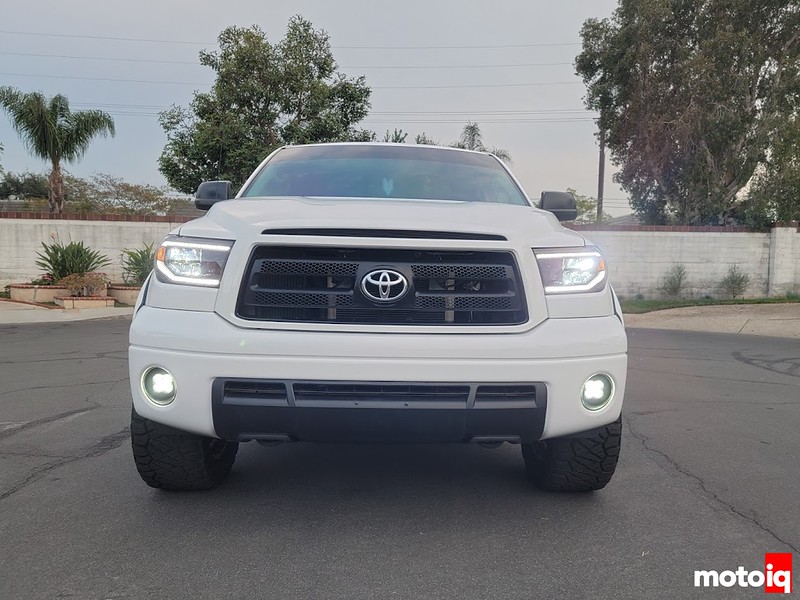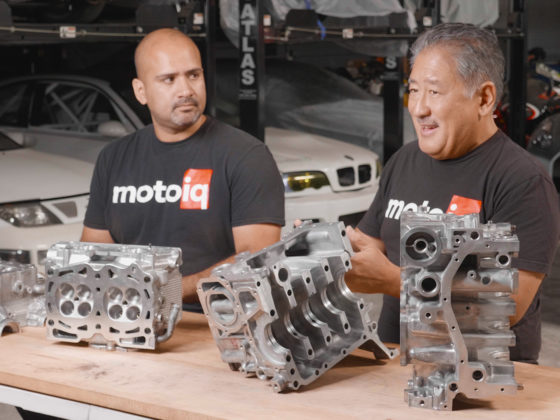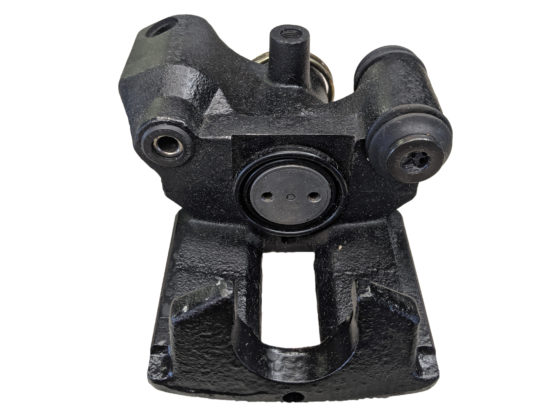
To replace our hazy OEM fog lights Turners suggested some lights from Diode Dynamics. These lights are DOT approved and meet SAE J581 standards for auxiliary lights. 
These lights use 4 led elements with TIR optics for the best possible legal beam pattern. TIR stands for total internal reflection and is the same technology used in high-quality tactical lights to make a useful and efficient beam. These lights produce 18,000 candela each.

The lights have generous heat sinks to control temperature. The lights have been extensively tested for long-term operation from -40 to 185 degrees F, along with vibration, moisture intrusion, and corrosion testing. All of these tests are completed to SAE standards, just like factory components.

An injection-molded bracket is provided to make the installation a straight bolt in. Adaptors are included to make the wiring plug-and-play as well.

We started our installation with the tail lights because it was the easiest. First, the two bolts that hold the taillight assemble in were removed.




6 comments
Wow, what a transformation! Really makes the truck look a generation newer than before, in terms of styling. And with the paint correction, it really looks like a much newer vehicle! Very nice truck!
We were amazed at the paint correction. I agree, the lights really update the looks of the truck.
Adding Paint Protection Film over the lenses will help ensure years of clear vision and help to prevent stone rash and degradation of the UV resistant layer of the polycarbonate.
We did just that!
I hate to bring this up, but these Morimoto headlamp units are not a legal or good upgrade over a brand new set of the original halogens.
First off, morimoto isn’t a quality brand, it’s a warrantied version of the offbrand junk you can get online with a good marketing program. I will admit they’ve recently taken on a professional automotive lighting engineer and their latest releases have tried to be a bit more legitimate, but nonetheless they commit plenty of offenses.
There is no such thing as DOT approval. And that may seem like a minor point, but it’s important – US DOT does no certify or approve headlamp assemblies – they simply provide the FMVSS108 regulations for manufacturers to follow. Good suppliers do their own photometric and functional/environmental testing which they can provide to the NHTSA if there is an investigation, but for end users, it’s simply a game of trust. And I wouldn’t trust a company that’s had lawsuits against it and runs in an industry full of illegal crap. I can’t know whether the original Koito(?) headlamps for this truck actually complied with the regulations but I’m more inclined to trust that Koito produced a quality compliant design than I am to trust a third party non OE supplier with a bad history and deceptive marketing.
I’ll admit that Morimoto has recently started providing photometric test results for some of their products, but there are some fundamental problems with these. For starters, these are not done by reputable testing companies and are fairly likely to be “rubber stamped” approvals. Furthermore, I’ve read through their published tests for their sealed vehicle specific headlamps and they have some marginal passes with reaiming or asterisks that indicate a problematic headlight output. Also, their environmental testing is bare minimum and I’ve heard from a top level expert that the UV clear coat they use for the polycarbonate lenses is the bare minimum stuff that is only meant for 2 (or 3) year resistance. It’s just most people installing these won’t actually keep the car or headlamps long enough to see hazing and problems and find out if their warranty is worth anything. Most OE headlamps can sit outside in the sun for a decade while being scrubbed with automatic washes and gas station window squeegees before they start to wear. Some last longer. Id be surprised if the Morimotos lasted more than 5, and I’ve seen people complaining about hazing and water intrusion on relatively new units.
And given all that, I don’t buy that they provide so much of an upgrade even ignoring all the introduced problems with using aftermarket parts in a safety system. Most of their high performance retrofit projectors don’t deliver performance and candela readings as high as good OEM units, and for the few that do outshine OE parts, they compromise them by ignoring glare limits at certain points, uplight minimums for retroreflective signs, and maximums at foreground test points. This makes a pretty beam that looks impressive for retrofitters but compromises distance vision by making the foreground light too bright and the uplight too dim while creating more glare. Their sealed vehicle specific units don’t use these high performance* projectors and may even be third party designs with their multiple small optic LED projectors/TIR. These tend to perform worse for intensity and glare, even in OEM designs, and the test results morimoto provides seem to confirm this detail because most of the units have ~40kCD maximum intensity or 50kCd at best. Max intensity readings are not the complete picture, but coupled with the unequal beam pattern and non-compliant readings in other locations it makes for a headlamp that doesn’t perform well enough to make up for the compromises.
Meanwhile, modern halogen headlamps have been improving in recent decades even if they appear to have been left behind HID and LED technology. Freeform computer modeled reflector technology was the biggest breakthrough about two decades ago, but there have been incremental improvements since that take advantage of newer halogens with higher intensity filaments and optimize reflector geometry. Couple that with the unabashedly large size of the Tundra’s headlamps, and you get the potential for solid headlight output. Photometric results for recent headlamps are hard to obtain, but they have easily outclassed the best headlamps from before this millennium which were hitting max intensities of 15-20kCd. Also, considering IIHS tests, a conservative calculation indicates that most modern halogen lamps easily hit 25-30kCd, while larger reflectors and projector halogens reach over 40kCd, which is the lower bound of HID performance and on par with mainstream LED headlamps. The total output may be slightly less than LED, but a bright foreground and lighting up the side of the road directly alongside your car isn’t as useful as enough light in the distance. Braking distances alone indicate that at speed, you can only react to road hazards hundreds of feet ahead – by the time they’re closer, all they’ll do is illuminate the deer as you brake hard and annihilate it.
On top of that, there’s some aftermarket optimizations you can do with halogen headlamps:
First off, a ten year old headlamp assembly will be pretty worn, losing at least 40% or more of its intensity because of the crazing and haze of the cover lens, UV and heat damage to the internal reflectors, and dust/grime/soot buildup that lowers the reflectance and transmission of your precious light. Most people with older cars would see a shocking benefit from new *OEM* headlamp assemblies (even CAPA headlamps are inferior and non-compliant).
Second, halogen bulbs lose output with wear from vaporized tungsten redepositing on the glass envelope and unevenly back on the filament. This means that all halogen bulbs, whether performance or long life, will lose 10-20% intensity after a year of standard driving, and even more as years go on. Even with standard bulbs, most people would be well served by replacing them yearly.
That said, you could get a bigger improvement with performance bulbs – Osram, Philips, GE, Sylvania, Bosch, Narva, Vosla, and a few others make some legitimate performance bulbs that optimize the bulb within legal parameters. They decrease envelope size and increase gas pressure to increase brightness, thin out the filament for higher intensity and higher power draw at the same voltage, and use special alloy and gas mixes to maximize the output and lifespan. Some even use partially tinted bulbs to reduce a filament that would otherwise produce too much output down to legal specifications while absorbing light emitted in less useful directions. On top of that, a questionable but safe practice is to replace certain bulbs with cross compatible higher output bulbs, such as H11 -> H9, H7 -> H18 or H7 Rallye, 9005 -> 9011, 9006 -> 9012 for a significant boost in light and no compromises.
Finally, since output is exponentially proportional to voltage, some people build or buy wiring harnesses that use thicker wiring and/or relays, or even voltage boosters to turn up the brightness to even higher levels at the cost of bulb life. Note that this is not the same as overwattage bulbs, which actually reduce surface luminance and distance intensity while increasing fire risk.
Oh, and I want to add that unlike other trucks, the Tundra actually uses dual bulb dual reflector headlamps that are much more efficient than even the best H4 or H13 headlamps. They can be upgraded to a good H11 and a 9011 HIR1 in the high beam for a very good total package and an amazing high beam that will keep up with the best OEM LEDs. I could maybe understand the desire to switch to an aftermarket headlamp assembly in a somewhat compromised H4 design, but with this stock headlamp there is no good reason to change it out. Contrary to a certain expert’s opinion, I think an H9 bulb with a high temp painted tip would do even better in the low beam for an 800 lumen increase at the expense of an extra 10W per side. I know it’s too late for this article, but if I change one person’s mind or the owners of this truck decide to redo their lamps once these aftermarket units fall apart, I’ll be satisfied.
So, I know it appears that the new headlamps are much better, but there is a good reason regulatory tests are done with advanced photometric measurement tools and tested extensively in multiple locations and beam angles. It’s fairly possible and likely that the total output and even the center intensity is higher on these than the old worn halogen headlamps with used bulbs, but that’s by far not a fair comparison. Additionally, the sharp cutoff Morimoto loves to show off is meaningless for performance and actually somewhat harmful for glare reduction purposes, at least in the degree they do it to compared to OEM projectors. And of course, our eyes perceive cool white light as brighter and with more glare than warm yellow halogen light, but this just contributes to glare while not actually making anything more visible. I was surprised by these results as well, but several scientific studies showed effectively equal results for road hazard spotting between headlamps with different color temperatures (at equal outputs).
Oh, and if you don’t believe me, I don’t exactly blame you, but I’m not just making this up – it’s regurgitated information coming from automotive lighting engineers and industry insiders with way more access, experience, and resources than any of us can see. This following Tacoma forum post by an engineer (although possibly not a lighting engineer) backs up most of my assertions and suggestions while demonstrating quantified results for the halogen upgrades I mentioned. Also, it’s worth checking out candlepowerforums’ automotive section for the two moderators that are industry insiders, as well as danielsternlighting, whose owner is a major expert and longtime enthusiast with more credentials than I could list. I’m linking a TTAC post that interviewed Dan Stern about this very topic and a CPF post advising lighting upgrades for a Tundra.
https://www.tacomaworld.com/threads/the-ultimate-headlight-upgrade-h4-not-led-or-hid.398066/
https://www.thetruthaboutcars.com/2015/03/piston-slap-traversing-world-led-retrofit-bulbs/
https://www.candlepowerforums.com/threads/85-90-or-100-real-watt-h9-or-h11.373392/post-4420136
My reply is that our lenses were in ok shape, not yellowed, only slightly fogged because they were under PPF film. The bulbs were Philips performance halogen replacements about 3 years old and the Morimoto headlights are an order of magnitude better for my driving! For sure the OEM headlights were degraded but not horribly so. The OEM lights have never impressed me, even when new. The Moriomoto lights have a good beam cut-off, don’t leak light where it’s not wanted, and don’t blind oncoming traffic. I can see tons better at night, it’s not that whiter light is fooling me, the amount and quality of the light is great and the distance I can see is probably tripled which is the important thing, and the truck looks a lot better. I think no one that goes crazy on these light posts has the correct equipment to do an accurate objective test. For me, my concerns are that I can see better and I don’t blind oncoming traffic and these lights do a good job at that.